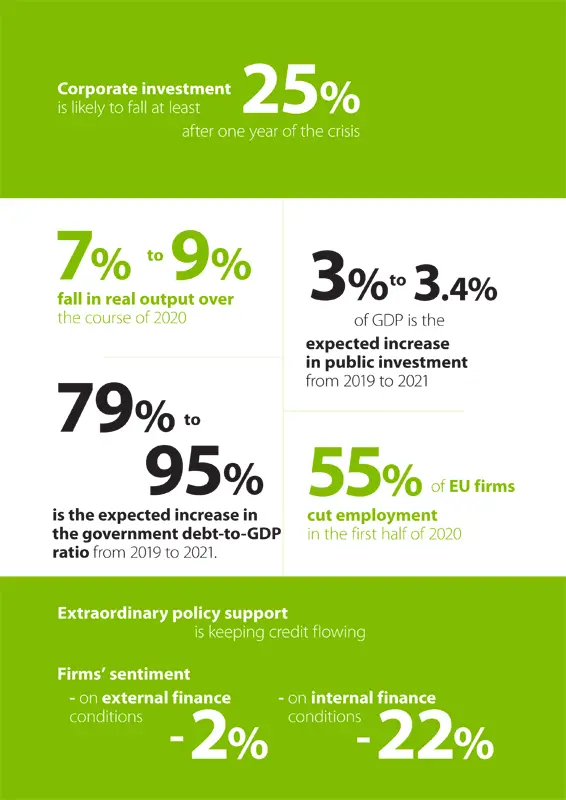The scale of the policy response risks weighing on government investment.The global financial crisis showed that large fiscal stimulus could be followed by a sharp fiscal correction in which government investment falls substantially. The temporary suspension of EU fiscal rules and the massive intervention of the ECB have eased the pressure on governments this time around, allowing them to maintain focus on productive public investment. The benefits should be considerable, since government investment often has a catalytic effect on private investment and positive spillovers to the rest of the EU economy.
Investment in climate change mitigation remains insufficient to achieve the ambitious EU target of achieving carbon neutrality by 2050. Chapter 4outlines recent investment trends in climate change mitigation and adaptation. While it acknowledges the recent uptick in climate-related investment in the European Union, it stresses the need for further substantial increases if the European Union is to meet its goal of carbon neutrality. To accelerate investment, EU governments and the private sector have important roles to play. Governments will have to scale up investment, but perhaps more importantly, their policy mix should shift towards incentives that will boost investment in climate action. Incentives are crucial because most of the investment needed to make the economy carbon neutral will have to come from the private sector.
The transformation of the economy is a major opportunity for all firms. Chapter 5focuses on the outstanding climate challenges facing the corporate sector. It probes the degree of awareness of EU firms and their willingness to deal with the effects of climate change. The chapter stresses that firms’ decisions to invest in climate-related measures will affect their competitiveness and determine whether they play an active or passive part in the transformation. Half of the firms in the European Union are investing in climate measures, and they show a stronger propensity to do so than their counterparts in the United States. That said, the pandemic might derail some firms’ investment plans, despite the significant spending needed to achieve the European Union’s ambitious targets. These developments underline the importance of the European Green Deal as a catalyst for the green transition. The green deal provides a coherent plan for defining investment in climate change mitigation and adaptation and lays out proper incentives for the public and private sectors. Businesses say they need clarity on the climate. Regulatory uncertainty and taxation are cited as the main impediments for climate-related corporate investment, according to 73% of EU firms.
The financial sector is an important enabler of the green transition. Chapter 6points out that investor interest is gradually shifting towards companies with clearly defined sustainability goals, but many issues remain. For instance, the uncertainty surrounding the true green content of financial assets reduces investors’ ability to assess their merits. Enhanced information and the development of simple and transparent standards should alleviate major impediments to stronger growth. The important role played by banks in the European Union will require enhanced disclosure about the exposure of bank assets to climate risks.
The digital transformation is taking centre stage, affecting virtually all sectors of the economy.The global innovation landscape is changing rapidly due to the growing importance of digital technologies and the emergence of China. Chapter 7notes how European firms are lagging when it comes to innovation in the fast-growing digital sectors such as software and computer services, which may create challenges for long-term competitiveness. Furthermore, European firms are not only trailing in digital innovation, but also in digital adoption. In the European Union, 37% of firms remain non-digital, compared with 26% in the United States. Firms say that access to digital infrastructure is more restricted in the European Union compared with the United States. Higher rates of digital innovation and adoption are linked to greater job creation and resilience, but also to higher investment in climate change mitigation and adaptation – investment that is crucial for achieving ambitious European climate targets.
Innovation in green technologies will play a key part in the transition to a carbon-neutral economy.Current technologies are insufficient for meeting the climate goal without significant disruptions to lifestyles in advanced economies or development in emerging economies. Hence, innovation is essential to producing the clean technologies needed for a smooth transition. Chapter 8builds on an analysis of patent data and the results of the online survey with Ipsos on green innovation to study the important symbiosis between digital and green technologies. The authors stress that technological advances will need to permeate every aspect of our lives, from energy systems to materials and land use, if we are to successfully navigate the transition to carbon neutrality. Digital technologies are expected to make a major contribution to these innovations.
The European Union is currently leading the way in the joint development of green and digital technologies.The transition will require more than creating knowledge. That knowledge will also have to be shared and adopted. The European Union also seems to excel in knowledge diffusion compared to global peers, but this diffusion tends to remain within national borders.
Efforts by cities and municipalities will be instrumental in building a digital and green future. Chapter 9shows that local government investment in green and digital infrastructure is important for pulling in private investment in climate measures. Gaps in green and digital infrastructure vary across the European Union and exacerbate regional inequality.
The report concludes by studying the impact of digitalisation and the green transition on social cohesion. Chapter 10looks at how digitalisation and the green transition will create and destroy jobs – while at the same time changing the relative importance of occupations. That upheaval will cause significant shifts in demand for labour, with profound social and economic consequences. This shift is likely to affect regions and countries in the European Union differently, with some parts at greater risk. Dealing with these risks will require strong local governments that can identify future job opportunities, provide adequate support for individuals and devise strategies to transform and revitalise local economies. Providing workers with the necessary skills is essential to managing the disruptions of the twin green and digital transition and to maximising its benefits.
Throughout the report, EU countries are often grouped into three regions with common features.Central and Eastern Europe contains the countries that have joined the European Union since 2004 and that rely substantially on EU cohesion and structural funds. Cyprus, Greece, Italy, Malta, Portugal and Spain form the Southern Europe group. The remaining EU countries are in Western and Northern Europe. While geographical location defines the groups, the countries within each group share many common structural economic characteristics, thereby justifying the regions’ usefulness in economic analysis.

PART I
Chapter 1
The macroeconomic environment
The measures taken to fight the coronavirus pandemic have severely disrupted the global economy.Trade and investment channels have been interrupted, the movement of people has been seriously restricted, and businesses have been forced to operate at reduced capacity or to temporarily abandon their operations. Confidence levels have fallen markedly and labour markets have frozen. Prior to the second lockdown, the International Monetary Fund (IMF) and other institutions were already expecting gross domestic product (GDP) in the European Union to shrink by 6% to 8%, a fall unrivalled since the Great Depression.
Читать дальше













